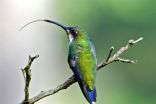(Press-News.org) DURHAM, N.C. -- It's obvious drought can kill trees. But a new Duke University study of nearly 29,000 trees at two research forests in North Carolina reveals it's not always a swift or predictable end.
"This is the first research to show that declines in tree growth during a drought can significantly reduce long-term tree survival in Southeastern forests for up to a decade after the drought ends," said Aaron Berdanier, a Ph.D. student in forest ecology at Duke's Nicholas School of the Environment, who led the study
By identifying the species at highest risk and the environmental factors that shape the odds of survival, the new study may give managers better ways to recognize and reverse drought-induced declines in the region's forests before it's too late, said James S. Clark, Nicholas Professor of Environmental Science at Duke.
"Foresters and ecologists have long gauged the severity of drought from tree mortality that happens the same year. But the damage suffered during drought sets in motion a decline that can kill trees years later. This study identifies the symptoms that can mark an individual for later death," Clark said.
"As our future climate warms and droughts in the Southeast become more frequent and severe, this is going to be a major region-wide concern," Clark added.
As tree growth slows during a drought, it decreases a tree's ability to take in enough carbon to stay alive, Berdanier said. If the tree can't reverse this trend, its health progressively declines and over time it slowly dies.
These declines are more gradual and less explicit than the catastrophic die-offs that have become increasingly common after major droughts in the West and other regions, but the long-term impacts can be severe.
Berdanier said that of the trees that were affected by drought and failed to recover, 72 percent were dead within the decade.
The findings appeared July 30 in the early online edition of the peer-reviewed journal Ecological Applications.
To conduct the study, Clark and Berdanier analyzed data dating back to 1993 on the annual growth rates of 28,879 individual trees from 35 species growing at the Duke University Forest in North Carolina's Piedmont, and at the Coweeta Long Term Ecological Research site in the state's western mountains.
Both sites are forested primarily with mature stands of mixed conifers and hardwoods -- typical of forests found across much of the Southeast -- and both sites experienced major droughts in 2000-02, 2007 and 2010. Growth rates were determined by measuring year-to-year changes in tree trunk diameters.
"Averaged across species, we found that a tree's long-term mortality risk increases when its cumulative diameter growth falls below 54 percent of the growth of nearby trees of the same species," Clark said. "This gives scientists and forest managers a useful measure to monitor for."
Trees growing on normally wetter sites and those from drought-tolerant species -- including the wood and furniture industry staples, loblolly pine and white oak -- are better able to recover their pre-drought growth rates after a drought ends.
Thinning out competing trees from around an injured tree can reduce its risk of death.
"After a drought occurs, managers may have a couple of years to do something to prevent declines from causing a tree's death," Berdanier said. "Knowing what to do and what to look for can make a big difference."
INFORMATION:
The study was funded by the National Science Foundation (#EF-1137364) and the University of Georgia-based Coweeta Long Term Ecological Research site.
CITATION: "Multi-year Drought-induced Morbidity Preceding Tree Death in Southeastern U.S. Forests," Aaron Baird Berdanier and James S. Clark; published July 30, 2015 (pre-print), Ecological Applications. DOI: http://dx.doi.org/10.1890/15-0274.1
GeoSpace
New study shows significant tsunami strength for parts of Southern California
A new simulation of tsunamis generated by earthquake faults off the Santa Barbara coast demonstrates a greater potential for tsunami inundation in the cites of Ventura and Oxnard than previously thought, according to a new study in Geophysical Research Letters.
Scientists track air pollution by meal times
Cars and trucks shouldn't take all of the blame for air pollution in Hong Kong. Smoke from cooking adds more of a specific type of pollution - organic aerosols - to the city's ...
New supercomputer models have come closer than ever to capturing the behavior of normal human heart valves and their replacements, according to recent studies by groups including scientists at the Institute for Computational Engineering and Sciences (ICES) at The University of Texas at Austin and the Department of Mechanical Engineering at Iowa State University.
The studies focused on how heart valve tissue responds to realistic blood flow. The new models can help doctors make more durable repair and replacement of heart valves.
"At the core of what we do is the development ...
Irvine, Calif., Aug. 19, 2015 -- Patients with hypertension treated with acupuncture experienced drops in their blood pressure that lasted up to a month and a half, researchers with the Susan Samueli Center for Integrative Medicine have found.
Their work is the first to scientifically confirm that this ancient Chinese practice is beneficial in treating mild to moderate hypertension, and it indicates that regular use could help people control their blood pressure and lessen their risk of stroke and heart disease.
"This clinical study is the culmination of more than a ...
Don't look now, but the pronoun "I" is becoming obsolete.
Recent microbiological research has shown that thinking of plants and animals, including humans, as autonomous individuals is a serious over-simplification.
A series of groundbreaking studies have revealed that what we have always thought of as individuals are actually "biomolecular networks" that consist of visible hosts plus millions of invisible microbes that have a significant effect on how the host develops, the diseases it catches, how it behaves and possibly even its social interactions.
"It's a case ...
A longstanding mystery about the tiny stars that let loose powerful explosions known as Type Ia supernovae might finally be solved.
For decades, astronomers have debated whether one white dwarf star, or two, is necessary for firing up this particular kind of supernova. The answer is not merely academic. Understanding the nitty-gritty physics and diversity of Type Ia supernovae will help illuminate our study of the evolution of galaxies and the strange cosmic force known as dark energy.
"It's about understanding one of the ultimate mysteries about stars," Laura Chomiuk, ...
In a paper titled Hummingbird tongues are elastic micropumps which appears in the August 19 issue of Proceedings of the Royal Society B, Alejandro Rico Guevara and Margaret Rubega from the Department of Ecology and Evolutionary Biology and Tai-Hsi Fan from the School of Engineering, say that fluid is actually drawn into the tongue by the elastic expansion of the tongues grooves after they are squeezed flat by the beak.
Their data shows that fifty years of research describing how hummingbirds and floral nectar have coevolved will have to be reconsidered.
What is actually ...
Researchers from North Carolina State University have developed an efficient algorithm that can interpret the wheezing of patients with breathing difficulties to give medical providers information about what's happening in the lungs. The research is part of a larger, ongoing project to develop wearable smart medical sensors for monitoring, collecting and interpreting personal health data.
The work was done by Saba Emrani and Hamid Krim, researchers in the National Science Foundation Nanosystems Engineering Research Center for Advanced Self-Powered Systems of Integrated ...
CHICAGO --- Polycystic ovary syndrome (PCOS) has been passed down in many families for generations -- causing reproductive and metabolic health problems for millions of women around the world. Yet, its cause remains unknown despite more than 80 years of research since the disorder was first described in 1935.
A new Northwestern Medicine genome-wide association study of PCOS -- the first of its kind to focus on women of European ancestry -- has provided important new insights into the underlying biology of the disorder.
Using the DNA of thousands of women and genotyping ...
LAWRENCE -- Compulsory schooling laws instituted in the late 1800s and early 1900s caused more people in Northern states to marry people at their same education level and race, possibly contributing to economic inequality, according to a University of Kansas researcher's study.
Emily Rauscher, a KU assistant professor of Sociology, found no increase in assortative mating in Southern states as a result of the laws, suggesting the influence of educational expansion on marital sorting depends on context.
"It's difficult to know why the compulsory laws had different effects ...
Solo travellers don't go alone because they have to, they do it because they want to, a new Queensland University of Technology study has found.
Professor Constanza (Connie) Bianchi, from QUT Business School, said there were a growing number of people who preferred to travel alone, despite having family and friends.
She said solo travellers were choosing freedom, uncompromised fun and meeting new people over the desire to have a companion to share their experiences.
In a study published in the International Journal of Tourism Research, Professor Bianchi looked at ...

